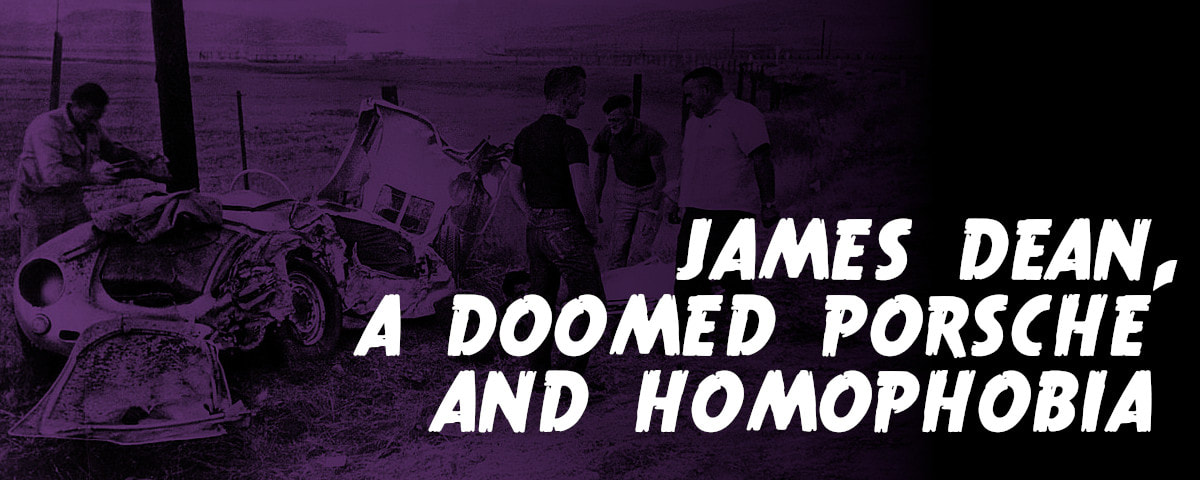Jason Colavito
Las Vegas Review-Journal
June 26, 2021
When movie star James Dean died in car crash at the age of 24 in 1955, teenagers nationwide burst into tears at the news. Four hundred fan clubs soon sprang up for the “Rebel Without a Cause” star, and he became in death the most beloved idol of a generation and the most famous movie star in the world.
Everyone knows his image even today — the surly look, the drooping cigarette, the red jacket and blue jeans. Generations of young men modeled themselves on him.
However, a planned new exhibit at a Las Vegas museum is set to tell visitors a false story about Dean rooted in half a century of homophobia.
Zak Bagans made his name purporting to hunt ghosts on the Travel Channel before opening his Haunted Museum in Las Vegas in 2017. He spent $382,000 last month to buy the transaxle assembly from the Porsche 550 Spyder in which Dean died. Bagans called the last remaining piece of the doomed car “the most famous cursed item in the world” and said buying it was “like striking gold.” He told the Review-Journal that he plans to dedicate an entire room of his paranormal museum to Dean.
Bagans believes a false legend that Dean’s car, and Dean, were intimately connected to the occult.
But the “curse” of Dean’s Porsche never existed. The story was assembled piecemeal. In 1956, two drivers who used salvaged pieces of Dean’s car in their own race cars suffered accidents in the same race, one fatal. A reporter was there to cover Dean’s “cult” of fans who had come to see the pieces of his car. Those fans called the double accident a “jinx,” but the surviving driver noted that the recycled parts played no role in either accident. The story was a one-day wonder, and life went on.
Two decades later, celebrity car customizer George Barris expanded the “jinx” story into a full-on supernatural curse tale in his 1974 book “Cars of the Stars,” with the addition of many doubtful and outright fabricated details. Now supposedly “cursed,” the parts became associated with a murder that never happened and several dubious accidents and injuries.
DC Comics adapted the falsified story for a 1975 comic, depicting Dean’s ghost hovering over scenes of death and injury. They called it “James Dean’s Curse on Wheels” and claimed the “weird hand of fate” took Dean to a “destiny with death.”
This time the curse story stuck and has since been featured in countless books, TV shows and soon Bagans’ museum. What changed?
Like any celebrity, Dean attracted his share of tabloid nonsense. In the 1950s, one paper falsely claimed that he was a satanist who practiced black magic with a corpse-eating biker cult. Another reported that a witch caused his death with a hex. These stories had little impact because legions of Dean’s fans took him for a hero and a model of masculinity.
Even bad-mouthing from disgruntled former friends and culture critics such as the novelist John Dos Pasos, who found him too effeminate, didn’t dent the legend.
But in 1974 and 1975, a series of biographies timed to mark the 20th anniversary of Dean’s passing reported that Dean had had several sexual relationships with other men. And that changed everything.
These revelations came a decade before any other star of his magnitude came out as gay or bisexual. The straight men who grew up idolizing Dean felt betrayed that their hero and role model was one of “those” people. The newly visible gay community adopted Dean as an icon. This only increased that sense of betrayal. An early Goo Goo Dolls song described the band’s disgust when “you found out Dean was gay.”
Stories about how James Dean was evil, cursed or somehow supernaturally deserving of death quickly gained in popularity — for sadly obvious reasons. The connection was never hidden. The playwright Venable Herndon made this clear in his 1974 Dean biography. He sought out the most derogatory and extreme rumors about Dean’s same-sex encounters and published them alongside Dean’s horoscope to “prove” that Dean’s fate was sealed in the stars. Soon enough, the tabloids carried new tales of Dean’s alleged occultism and longing for death, the only fate considered proper for queer people.
The story of the cursed car gained popularity and kept growing for a similar reason. It symbolically said that divine fate would strike down a sexual sinner and any who had commerce with him. This Pride Month, it’s worth asking if we still want to be entertained by made-up old stories that tell us queer people are cursed and deserve to die.
Everyone knows his image even today — the surly look, the drooping cigarette, the red jacket and blue jeans. Generations of young men modeled themselves on him.
However, a planned new exhibit at a Las Vegas museum is set to tell visitors a false story about Dean rooted in half a century of homophobia.
Zak Bagans made his name purporting to hunt ghosts on the Travel Channel before opening his Haunted Museum in Las Vegas in 2017. He spent $382,000 last month to buy the transaxle assembly from the Porsche 550 Spyder in which Dean died. Bagans called the last remaining piece of the doomed car “the most famous cursed item in the world” and said buying it was “like striking gold.” He told the Review-Journal that he plans to dedicate an entire room of his paranormal museum to Dean.
Bagans believes a false legend that Dean’s car, and Dean, were intimately connected to the occult.
But the “curse” of Dean’s Porsche never existed. The story was assembled piecemeal. In 1956, two drivers who used salvaged pieces of Dean’s car in their own race cars suffered accidents in the same race, one fatal. A reporter was there to cover Dean’s “cult” of fans who had come to see the pieces of his car. Those fans called the double accident a “jinx,” but the surviving driver noted that the recycled parts played no role in either accident. The story was a one-day wonder, and life went on.
Two decades later, celebrity car customizer George Barris expanded the “jinx” story into a full-on supernatural curse tale in his 1974 book “Cars of the Stars,” with the addition of many doubtful and outright fabricated details. Now supposedly “cursed,” the parts became associated with a murder that never happened and several dubious accidents and injuries.
DC Comics adapted the falsified story for a 1975 comic, depicting Dean’s ghost hovering over scenes of death and injury. They called it “James Dean’s Curse on Wheels” and claimed the “weird hand of fate” took Dean to a “destiny with death.”
This time the curse story stuck and has since been featured in countless books, TV shows and soon Bagans’ museum. What changed?
Like any celebrity, Dean attracted his share of tabloid nonsense. In the 1950s, one paper falsely claimed that he was a satanist who practiced black magic with a corpse-eating biker cult. Another reported that a witch caused his death with a hex. These stories had little impact because legions of Dean’s fans took him for a hero and a model of masculinity.
Even bad-mouthing from disgruntled former friends and culture critics such as the novelist John Dos Pasos, who found him too effeminate, didn’t dent the legend.
But in 1974 and 1975, a series of biographies timed to mark the 20th anniversary of Dean’s passing reported that Dean had had several sexual relationships with other men. And that changed everything.
These revelations came a decade before any other star of his magnitude came out as gay or bisexual. The straight men who grew up idolizing Dean felt betrayed that their hero and role model was one of “those” people. The newly visible gay community adopted Dean as an icon. This only increased that sense of betrayal. An early Goo Goo Dolls song described the band’s disgust when “you found out Dean was gay.”
Stories about how James Dean was evil, cursed or somehow supernaturally deserving of death quickly gained in popularity — for sadly obvious reasons. The connection was never hidden. The playwright Venable Herndon made this clear in his 1974 Dean biography. He sought out the most derogatory and extreme rumors about Dean’s same-sex encounters and published them alongside Dean’s horoscope to “prove” that Dean’s fate was sealed in the stars. Soon enough, the tabloids carried new tales of Dean’s alleged occultism and longing for death, the only fate considered proper for queer people.
The story of the cursed car gained popularity and kept growing for a similar reason. It symbolically said that divine fate would strike down a sexual sinner and any who had commerce with him. This Pride Month, it’s worth asking if we still want to be entertained by made-up old stories that tell us queer people are cursed and deserve to die.



